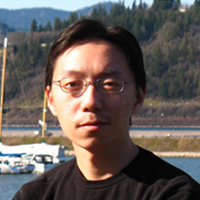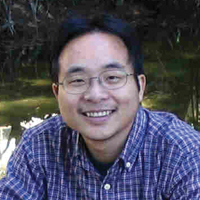Turning Frustration into Next-Generation Devices
Semiconductors (silicon being the most well-known) have worked tremendously well for a very long time, and their marriage with integrated circuits has successfully fueled the electronics industry. Your computer and smartphone would never have been possible without them.


Yet considering that the first integrated circuit was born 60 years ago, the demand continues to grow for electronics that can function in ever-smaller and more complex systems beyond what traditional semiconductors can deliver. Assistant Professor Jian Liu and Associate Professor Haidong Zhou have won a $400,000 Department of Energy grant to look for new possibilities in response to that need. They are creating quantum-scale materials and taking advantage of their inherent physical properties to influence how electrons behave.
Liu and Zhou will be working with geometrically-frustrated quantum magnets. Every electron has a spin—it’s a basic property of their existence. In many materials where the atomic structure is in a square lattice formation, the electron spins alternate at each corner—up, down, up, down (or ferromagnetic and antiferromagnetic). In a frustrated lattice that’s shaped like a triangle, the spins don’t know what to do because if a pair of them alternate up-and-down you end up with their common neighbors that have identical spins, frustrating the spins and minimizing the overall energy of the system. Geometrically-frustrated quantum magnets (GFQM) then, are typically very good insulators, meaning they inhibit the movement of electrons. This may seem to disqualify such materials from integrated circuit technology, but in fact there’s no reason to dismiss them.
"In principle, in an insulating material the spin is already there," Zhou explained. "So if you can find a way, you still can use them." As he and Liu explain in their proposal, a closer look at these magnets shows that novel properties tied to their complex geometry actually make them promising candidates for revolutionary computational technologies, including quantum computing.
Part of what makes frustrated magnets interesting is also what makes them somewhat complicated. To ease the frustration, the spins may decide to collectively switch between the up-and-down configurations thanks to quantum mechanics, leading to highly-entangled spin states and exotic collective excitations. Liu and Zhou want to capitalize on those properties by seeing what happens at the interface when these insulating quantum magnets interface with mobile electrons. The plan is to tame their collective entanglements to give rise to unusual electronic transport properties. To observe this, they will study three different materials. There are the frustrated magnets: a quantum spin ice (Dy2Ti2O7) and a quantum spin liquid (Tb2Ti2O7). Then there’s the metal (Bi2Ir2O7).
Spin ice and spin liquid don’t actually have anything to do with water aside from descriptive purposes. In the spin ice, there are two spin states pointing outward and two pointing inward, analogous to the two short and two long hydrogen and oxygen bonds in water ice. A spin liquid, as Liu explained, is sort of like water in that "if you change one water molecule, another water molecule some distance away will kind of know what’s happening."
Zhou continued that two spins in a spin liquid "quantum mechanically talk to each other. They’re bonded to each other; you cannot separate them. You have to look as these two spins as one."
This coupling can help make a computer based on this kind of quantum system unhackable, he said, because the information is composed of a total wave function—quantum bit.
"Say if you want to steal one bit of information, because of the link—we call it entanglement—all the information would be destroyed when you try to look it," he continued. "As soon as you try to probe it, it can be destroyed, and then you don’t have the information anymore."
So how does one exploit these materials for possible applications?
"The general idea is that we have some spin liquids and spin ice magnets that are interesting," Liu said. "The issue is that they don’t give you any electrical output, so we would like to use the metal to try to generate some electrical output. If it does, we would like to understand why it does and how it does."
Liu and Zhou will literally build the systems they want to study by synthesizing all the materials needed. The samples have a slight lattice mismatch—meaning their atomic structure varies by a small degree (in this case 2 percent). That variation will make each combined system a heterostructure. In the first instance, they will use single crystals of the frustrated magnets as a base layer and on top of that deposit a few atomic layers of the metal. They will look at the interface and see what kind of electronic properties emerge. If successful, they’ll synthesize multilayer samples where the magnet and metal layers are stacked alternatively.
"We’re going to start with the simplest geometry, where we have a crystal and I’m going to grow a metal layer on top so there’s only one interface,” Liu said. “It’s the simplest prototype that one can have. If it’s promising, you’d like to have more of those interfaces." The metal they’re using has spin-orbit entanglements as well, which the physicists hypothesize will play a key role. "If you take any regular metal, each mobile electron would have a spin—either spin up or spin down," Liu said. "Those two behave the same way. But it you have spin-orbit-coupling, then the spin-up electron moving forward would behave somehow differently from the spin-down electron moving forward."
Differentiation in those two kinds of electrons is why he and Zhou think the experiment has a chance to generate electrical output. The idea is that when the electrons in this metal move, they’ll bounce off the interface of the spin ice or spin liquid, and the spin of the moving electrons will sense what’s going on at the other side of the interface and the two sides will communicate with one another.
Zhou has a long and successful track record of growing single crystal materials and Liu has had enviable experience and success in growing thin films. With the resources of their on-campus labs at the Joint Institute for Advanced Materials, they can work together easily.
"One of the nicest things about this department is I can collaborate with almost anyone in the condensed matter program," Liu said. "This is one example."
Such collaborations are certainly fruitful. Understanding the effects at the interfaces of heterostructures made from quantum magnets would be a step toward making them function with integrated electronic technology, and as Liu pointed out, "there’s nothing easier than electric power. You plug it in the wall and it’s done."